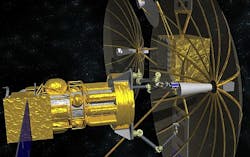DARPA releases solicitation for program to reuse parts from orbiting dead satellites
ARLINGTON, Va., 8 March, 2013. Spacecraft experts at the U.S. Defense Advanced Research Projects Agency (DARPA) in Arlington, Va., have released a formal solicitation for the Phoenix program, which seeks to reuse satellite antennas, apertures, and other components from decommissioned satellites.
The DARPA Phoenix solicitation (DARPA-BAA-13-12), released this week, seeks to develop technologies to harvest and re-use satellite components from retired, cooperative, non-operating spacecraft in or near geosynchronous orbit (GEO).
The idea is to use still-good components from dead satellites parked in high-Earth orbit for building new satellites robotically while in orbit to reduce the costs of replacing failed satellites.
Phoenix seeks to demonstrate around-the-clock, globally persistent communication capability for warfighters more economically by robotically removing and re-using GEO-based space apertures and antennas from de-commissioned satellites in the graveyard or disposal orbit.
DARPA is asking industry to develop an integrated proximity awareness system (IPAS), rendezvous and proximity operations (RPO) technology suite, synergistic number of degrees of freedom (N-DOF) test facility support, virtual ground station operations, and payload orbital delivery system (PODS)-hosted launch.
Through Phoenix, DARPA seeks to speed deployment of emerging technologies into on-orbit space systems at much lower cost than is possible today.
The idea behind Phoenix is that building new satellites robotically in orbit using recycled components would be much less expensive than simply junking failed satellites, and building and launching new ones from scratch.
These satellites would operate in geosynchronous orbit, which matches the speed of the Earth's rotation and makes them operate in one spot above the planet's surface. Stationary orbits are extremely high, and repairing or retrieving failing spacecraft at these distances today is nearly impossible.
Government experts have established a graveyard, or disposal, orbit high above the Earth's surface where decommissioned spacecraft pose little risk of colliding with functioning satellites. The graveyard orbit is necessary because de-orbiting these high-altitude satellites is dangerous and expensive.
Until now, the graveyard orbit has been a celestial junkyard filled with decommissioned satellites of no use to anyone. Even tough they no longer function, however, these junked satellites often still have useful components like antennas and sensors.
DARPA officials want to launch orbiting robots that can salvage still-useful satellite components from the graveyard orbit and use them to build new satellites. Spacecraft in geosynchronous orbit are particularly useful for military and civil communications and persistent surveillance.
A previous DARPA solicitation requested industry proposals for satlets, a payload orbital delivery system (PODS) to orbit satlets quickly, and a separate on-orbit satellite servicing spacecraft with grasping mechanical arms and robotic tools to salvage spacecraft components and construct a new satellites.
Companies interested in participating in the Phoenix program should respond no later than 19 April 2013. Send proposals by post to DARPA/TTO, ATTN: BAA 13-12, 675 North Randolph St., Arlington, VA 22203-2114.
For questions or concerns contact DARPA's David Barnhart by email at [email protected], or by fax at 703-807-9946.
More information is online at https://www.fbo.gov/spg/ODA/DARPA/CMO/DARPA-BAA-13-12/listing.html.

